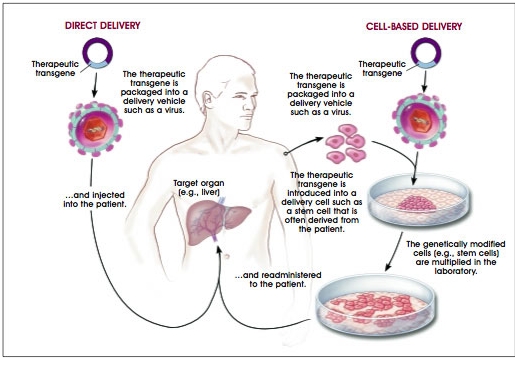Ex vivo delivery can also be called cell-based delivery protocol of gene therapy. It is different from in vivo delivery protocol – which is a direct delivery technique of delivering or injecting a functional gene into the host. Ex vivo delivery is the gene therapy technique in which cells extracted from a patient are genetically engineered in vitro and then re-introduced into the host’s body.
Such extracted cells must be capable of survival outside the host’s body and re-implantation into the body (after they must have been transformed) before they can qualify to be used for ex vivo gene therapy. Desired genes or proteins known as transgenes (i.e. genetically modified genes) are inserted into the body where they are expected to bring out the desired response after being transformed in vitro.
The cells of the body usually targeted by the ex vivo gene therapy technique include cells of the bone marrow, muscles, liver and fibroblasts amongst others. Ex vivo gene therapy employ non-viral vectors or techniques to deliver therapeutic genes or DNA into the cells of a host; and they are normally easy to use. Unlike the viral vectors that is normally associated with adverse host cell response; non-viral vectors used for ex vivo gene techniques are not capable of stimulating the host immune response.
Ex vivo gene therapy delivers desired genes that have been extracted and modified from outside the body; and they are usually not as specific as the in vivo delivery method that uses viruses as their vector. Ex vivo gene therapy is generally achieved through the process of transfection which is the in vitro introduction of proteins or DNA into cells. Non-viral techniques used for ex vivo gene therapy include lipofection, microinjection, electroporation, the use of naked DNA or plasmids and the use of calcium phosphate precipitate and liposome’s amongst other techniques.
Though much safer than the use of viruses, non-viral vectors at usually inefficient at transforming genes and some of the techniques or approaches used are not specific in action. Non-viral vectors or delivery systems are fast becoming the alternatives to the use of viral vectors in delivering therapeutic genes or DNA into hosts cells due to the safety and health risks or concerns of the later (i.e. the viral vectors).
Understanding the in vivo cellular barriers and other cellular restrictions in the host cell that impede the efficient delivery of therapeutic genes or DNA will help in developing efficient gene delivery systems that will ensure proficient expression of the delivered gene within the limits of the targeted hosts cells.
After their successful delivery, it is critical that the inserted therapeutic DNA or genes continue to express their encoded gene products (e.g. enzymes or proteins) within the cells or tissues of the host because this will help to guarantee a thriving repair of the mutated gene responsible for the genetic disorder.
References
Alberts B, Bray D, Johnson A, Lewis J, Raff M, Roberts K and Walter P (1998). Essential Cell Biology: An Introduction to the Molecular Biology of the Cell. Third edition. Garland Publishing Inc., New York.
Dale J (2003). Molecular genetics of bacteria. Jeremy W. Dale and Simon Park (4th eds.). John Wiley & Sons Ltd, West Sussex, UK.
Edelstein, M. L., Abedi, M. R., Wixon, J., and Edelstein, R. M. (2004). Gene therapy clinical trials worldwide 1989-2004—an overview. J Gene Med, 6: 597-602.
Ferrua, F.; Brigida, I.; Aiuti, A. (2010). Update on gene therapy for adenosine deaminase-deficient severe combined immunodeficiency. Current Opinion in Allergy and Clinical Immunology. 10 (6): 551–556.
Gardlík R, Pálffy R, Hodosy J, Lukács J, Turna J, Celec P; Pálffy; Hodosy; Lukács; Turna; Celec (2005). Vectors and delivery systems in gene therapy. Med Sci Monit. 11 (4): RA110–21.
Horn PA, Morris JC, Neff T, Kiem HP; Morris; Neff; Kiem (2004). Stem cell gene transfer—efficacy and safety in large animal studies. Mol. Ther. 10 (3): 417–31.
S Li and L Huang (2000). Nonviral gene therapy: promises and challenges. Gene Therapy, 7:31-34. www.nature.com/gt
Salmons B, Günzburg WH; Günzburg (1993). Targeting of retroviral vectors for gene therapy. Hum Gene Ther. 4 (2): 129–41.
Sambrook, J., Russell, D.W. (2001). Molecular Cloning: a Laboratory Manual, 3rd edn. Cold Spring Harbor Laboratory Press, New York.
Sheridan C (2011). Gene therapy finds its niche. Nature Biotechnology. 29 (2): 121–128.
Vannucci, L; Lai, M; Chiuppesi, F; Ceccherini-Nelli, L; Pistello, M (2013). Viral vectors: A look back and ahead on gene transfer technology. The new microbiologica. 36 (1): 1–22.
Discover more from Microbiology Class
Subscribe to get the latest posts sent to your email.





